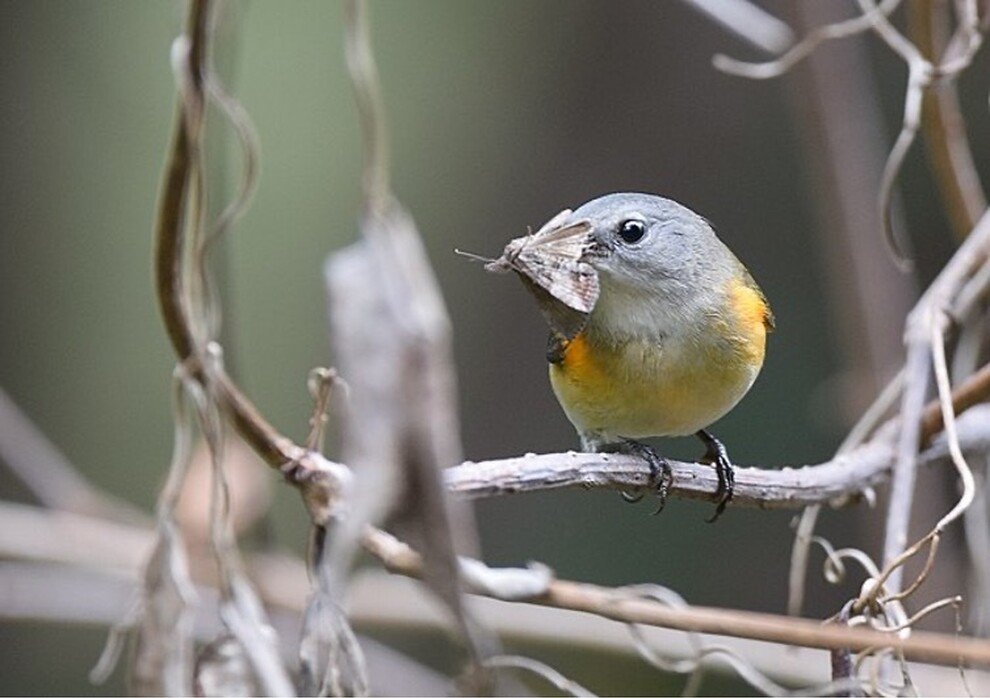Current Nature: World Migratory Bird Day - Why This Year Is All About Insects
Jenny Kafas, Conservation Research and Stewardship Intern at the Linda Loring Nature Foundation
October 12th is World Migratory Bird Day. This time of year, millions of birds are migrating south for the winter, many of which make stops here on Nantucket. World Migratory Bird Day falls around the peak of migration and has been around since 2006. This event brings awareness to the importance of protecting migratory birds since their populations are declining at an alarming rate largely due to human activity. Every year WMBD has a different theme that emphasizes the importance of protecting these birds. This year's theme is insects!
Insects are an important food source for many birds for their long migration journeys. Birds bulk up on insects before taking off and eat them at rest points along their route. They are also vital for rearing young in most bird species. When adult birds feed their young, one of their main food sources are caterpillars because they are high in nutrients and are soft enough for the chicks to eat without scratching their throats. After reaching adulthood, these birds will expand their diet to include a larger variety of insects. Since insects are crucial for birds, their populations are highly interconnected, and major changes in one will have repercussions for the other.
An American redstart eating a moth.
In recent years, bird populations have been declining rapidly; a trend that has been seen more dramatically in migratory bird populations. This is largely due to a massive insect decline that has been seen in recent decades. So what’s causing the decline of insects, and what can we do about it?
In recent years, we as humans have altered our ecosystem tremendously. Not just by creating cities and paving roads, but with our farms, offices, parks, and neighborhoods, which we tend to manicure with lawns and landscape with non-native plants. Grass and ornamental plants are indeed plants, but they generally do not provide support for insects. This is because insects are generally host specific meaning that they can feed on only one or few plant species. This is a result of the long evolutionary history that local native insects share with native plants. A great way to support your local insect and bird populations is by reducing lawn space where you can, and planting native plants. A diversity of native plants will attract a diversity of insects.
A Pandorus Sphinx (Eumorpha pandorus) found on Madaket road. This species will only feed on plants in the grape family.
Which of these yards do you think supports more insects and birds?
Another effective way to support insects is by replacing your outdoor lights with yellow LED lights. Insects are more active at night than during the day, and nocturnal insects often become victims of the lights we put up at night. Insects will fly toward light during vital feeding hours, often to the point of exhaustion and death. The lights we have up at night contribute significantly to insect declines, but recently scientists have found that yellow lights don’t have these same effects on them. While we’re not sure why this is the case, we do know that using yellow lights can make a great difference.
A house lighting their front porch with a yellow light.
During this time of year, many homeowners feel the urge to rake their leaves out of fear that the leaves will kill their plantings or lawns. However, leaf litter provides a valuable habitat for insects to overwinter and can benefit the growth underneath it. Unless your plants or lawn are completely inundated with leaves, the leaf litter will provide water filtration and storage that prevents flooding, and it can also help keep nutrients in the soil without killing what’s underneath it. Many insects rely on fallen leaves to complete their life cycles, including butterflies that create cocoons that resemble dried leaves, bumble bees that burrow in shallow ground and rely on an additional layer of leaf litter for insulation, and a large variety of beetles, mites, and more. Be mindful that removing leaves also removes a whole leaf litter ecosystem.
Another way we are making our gardens unwelcoming to insects and birds is by using harmful fertilizers and herbicides. These chemicals will kill most insects directly or by changing the chemistry of their host plants so that they can no longer eat them. Reducing the use of fertilizers and herbicides is another way to help insects, and if you plant native, you can completely eliminate the need for both of them.
A swallowtail butterfly found at the Linda Loring Nature Foundation. Swallowtails make cocoons that mimic leaf litter so predators can’t find them among fallen leaves in the winter.
Making these changes to your yard comes with the best reward – birds! Many of our local migratory birds, such as Grey Catbirds, Northern Cardinals, Carolina Wrens, and Eastern Towhees will return to the same nesting area every year. They are far more likely to do so if there is a healthy population of insects for them to feed on.
Want to see migratory songbirds and celebrate Migratory Bird Day? Follow LLNF on social media to learn about the birding tours and bird banding events we are offering this week!
Stay tuned for more editions of Current Nature, a bi-weekly column featuring seasonal topics, natural history information, and advice on the outdoors from the staff at the Linda Loring Nature Foundation.





